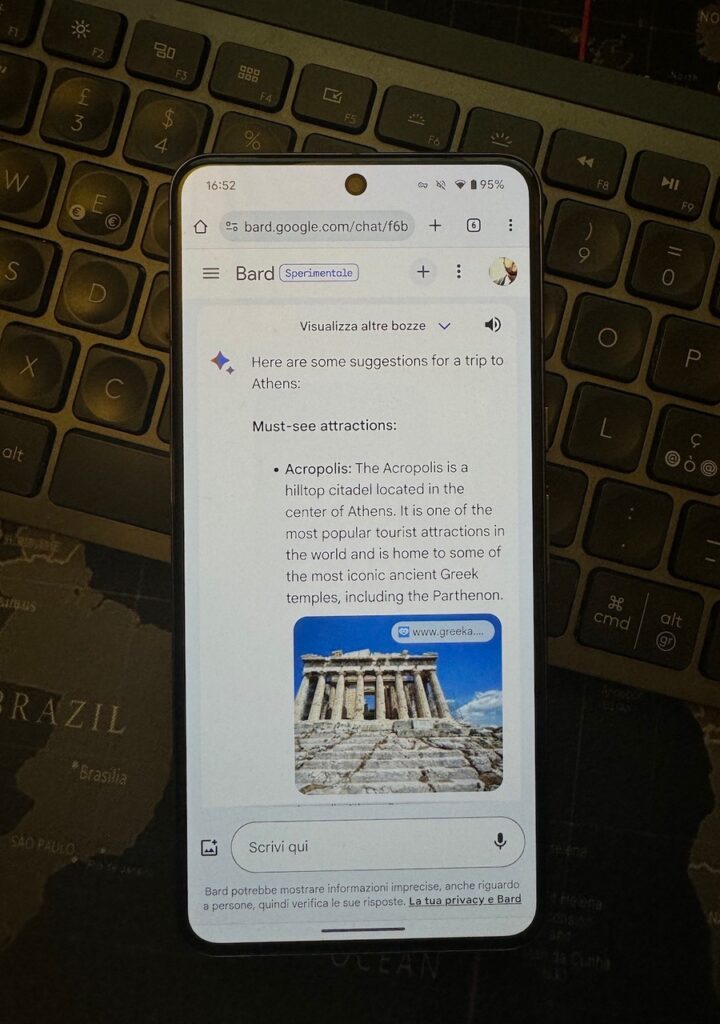Photographic performance and lots of AI: the test of the Pixel 8 Pro
If there is something Google does better than others, it integrates all its products into a large and complete ecosystem. Apple has been doing it for years, but Big G is the only one that can count on practically every type of hi-tech product, both hardware and software. For this reason, the consumer familiar with more than one Google service will only love the new Pixel 8 Pro. The largest of the company’s latest family of phones has many arrows in its bow, more than it has, inevitably, its younger brother, the Pixel 8, which, although it defends itself well in its niche, lacks a telephoto lens and a temperature sensor, currently a bit limited but still a peculiarity on the mobile market.
Pixel 8 Pro, how it’s made
Let’s focus on the Pixel 8 Pro then. The phone features a refined aluminium and glass design. The 6.7-inch Oled screen is flat, not curved at the edges, as was the case on previous Pixel Pros. It’s incredibly smooth for scrolling and can reach a peak brightness of 2,400 nits, even if only for a few minutes in the sun, before attenuating to still readable levels. New this year is an updated face unlock system capable of authenticating payments and unlocking the phone. It’s not as advanced as Apple’s Face ID, and it doesn’t work with sunglasses or in low light, but it’s useful in combination with fingerprint reading.
The new Tensor G3 chip lags slightly behind major Qualcomm and Apple-branded rivals, at least on paper, but it handles games, apps, and general usability without any issues. Furthermore, a central part of the experience is focused on data security and privacy: Tensor keeps the user’s most sensitive information separate in a physical location different from that of the processor, recalling it only when necessary to defend it from possible intrusions hackers.
Battery life is more or less the same as the Pixel 7 Pro, sufficient for even intense daily use, and about 85 minutes of charging, from zero to one hundred, with a 30 Watt charger, not included in the package. As anticipated, under the rear camera, there is a temperature sensor that can measure the temperature of any object it approaches, except fever. For that, we will have to wait for authorization from the US FDA, which should not be long in coming.
Generative AI
One of the most important innovations of the Pixel 8 is the much longer software support compared to the past. Both smartphones run Android 14 and promise seven years of OS updates and security patches. This means the 8 Pro can be updated at least until October 2030. A significant detail brings Google to the same level as Apple’s iPhone and surpasses other manufacturers, including Samsung, by at least two years. Only Fairphone, the dubiously successful detachable phone, offers more, with ten years of support.
Google has joined the much-hyped generative AI bandwagon, adding the technology to many more sections of the Pixel 8 Pro and hinting at the soon arrival of its mobile chatbot, Bard. For the moment, the only ones with access to the first generative AI features are users in the United States, who speak of a significant step forward for the range. We can mention Google Assistant’s ability to summarize websites and articles, even reading them aloud. Then, there is an interesting wallpaper generator, starting from some textual indication the user provides. As on Bing, just ask Bard for the image you want, one already vertical, ready to be used as the phone’s wallpaper. The possibility of transcribing text starting from voice recognition is of no small importance. Google has updated the algorithm to insert pauses and various punctuations, with support in dozens of languages.

Photos editing
A further AI inference in the Pixel 8 Pro’s software is in the Google Photos app, to which the “Magic Editor” functionality has been added. This allows you to select people and objects to move or resize them in images, replace the sky or reorient the light, using artificial intelligence to regenerate parts of the photo so that everything blends together. The software produces four options at a time to choose from, with the opportunity for additional alternatives. This is new in beta, which can take up to a minute to complete the job, which, once finished, can produce truly “magical” results.
“Best Shot” is another new Pixel feature designed to produce a group shot of people where everyone looks their best by combining faces from multiple images into a single photo. This works with most group shots already in Google Photos, not just new ones captured by the 8 Pro. Finally, the new Audio Magic Eraser can analyze videos and break down sounds into different channels, allowing you to reduce their volume independently, such as road noise in a city scene or a plane flying while recording music.
The result is not always perfect, but considering the user does not have to do almost anything to improve the video, the final content is more than considerable. Google promises many more generative AI features in upcoming updates, including a solution to enlarge and sharpen existing images, which uses a combination of on-device AI and the power of the company’s servers to process the files.
Photo quality
Google’s Pixels have long boasted some of the best cameras on the market, and the 8 Pro is no exception. The hardware has been updated across the board with larger, brighter sensors than its predecessors, improving low-light shots and reducing blur in fast-moving scenes. There are lots of fun, automatic features to play with. Still, for the first time, the 8 Pro also features full manual controls, allowing you to shoot 50-megapixel raw images (or digital negatives) and adjust shutter speed, sensitivity and focus. Overall, the 8 Pro produces impactful photos with minimal effort in often tricky situations, making the phone the perfect tool for point-and-shoot.
The Final Verdict
The screen, materials, performance and battery life are the pluses of this phone. The Pixel 8 Pro has a distinctive appearance that makes it recognizable among the plethora of Android offers, at prices certainly lower than those offered by the latest addition to Google, whose price tag starts at 1,099 euros. But here, every euro is worth the expense: either for the simplicity with which true masterpieces are shot or for the numerous opportunities to exploit the first “serious” applications of generative artificial intelligence, from improving one’s own photo to taking notes by voice, transcribed automatically. Of course, it is not yet the revolution that is expected from AIi.
Still, Google shows that it wants to look far ahead with its Pixel 8 Pro, already anticipating the bulk of the next updates and enticing buyers with the seven years of software support, which brought the phone to on par with Apple. Definitely, it is a great step in the right direction for hi-tech sustainability.



